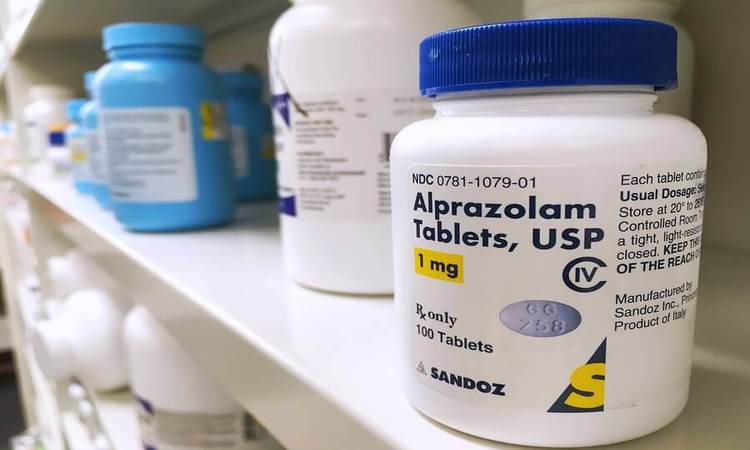
Xanax (alprazolam) is a prescription medication that belongs to a class of drugs called benzodiazepines (commonly referred to as benzos) which are most often used to treat anxiety, panic disorder, and insomnia.
Benzos have a high potential for dependency, meaning that cessation of use can result in the following Xanax withdrawal symptoms:
- Nausea, vomiting, and diarrhea
- Dizziness
- Excessive perspiration
- Drowsiness and fatigue
- Confusion or paranoia
- Depression
- Anxiety and panic attacks
- Irritability or agitation
- Tremors or shaking
- Memory loss
- Rapid heartbeat (tachycardia)
- Difficulty concentrating
- Convulsions or seizures
- Sore, stiff muscles
- Muscle spasms or twitches
- Headache
- Weight loss or weight gain
- Insomnia or restless sleep
- Heart palpitations (tachycardia)
Dependency is caused by the brain’s propensity to adjust to the presence of certain drugs and become less able to function per usual without them. Xanax dependency is characterized by its depressive effects, and when a user attempts to quit or cut back, this often results in an overreaction of the central nervous system (Xanax withdrawal symptoms) including feelings of nervousness, anxiety, and insomnia.
How Does Xanax Work?
Benzos work by boosting the effect of a brain neurochemical gamma-aminobutyric acid (GABA) in the brain. GABA’s mechanism of action is to mitigate activity in the central nervous system, resulting in relaxation and a reduction of anxiety.
Like many prescription drugs, Xanax use can result in a host of adverse effects, which include but are not limited to the following:
- Drowsiness and lethargy
- Dizziness
- Sleep disturbances
- Memory problems
- Poor balance or coordination
- Slurred speech
- Difficulty concentrating
- Irritability
- Diarrhea or Constipation
- Increased perspiration
- Headache
- Nausea and vomiting
- Blurred vision
- Appetite or weight changes
- Swelling in hands or feet
- Muscle weakness
- Dry mouth
- Stuffy nose
- A decrease in libido (reduced interest in sex)
- Dependence and addiction
What is Tolerance?
Tolerance is a condition that occurs over time after the continued use of a substance. Moreover, the brain tends to reduce the response of a drug, simply described as “repeated exposure = diminished response.” When response decreases, the user feels compelled to consume more of the drug in an effort to achieve the desired effects he or she previously enjoyed.
Overdose
Benzodiazepines are not easy to fatally overdose on in of themselves, but can easily prove deadly when used with other psychoactive substances, particularly other depressant drugs or alcohol. This is known as combined drug intoxication (CDI).
According to the Centers for Disease Control and Prevention (CDC), in 2016, there were more than 63,000 drug overdose deaths in the United States, and more than 10,000 of these (about 1 in 6) involved the use of a benzodiazepine such as Xanax. Most fatalities related to benzos also included the use of some opioid, either prescription (e.g., oxycodone) or illicit (e.g., heroin or fentanyl.)
Overdoses of Xanax can range from mild to severe depending on the amount consumed and if other drugs are taken in combination. Overdose symptoms due to Xanax abuse or CDI may include the following:
- Confusion and disorientation
- Dizziness and fainting
- Shallow breathing (hypoventilation)
- Cyanosis – bluish or purple fingernails and lips
- Blurred or double vision
- Uncoordinated muscle movements and weakness
- Impaired motor functions, balance, and reflexes
- Noticeably altered mental status
- Low blood pressure (hypotension)
- Profound central nervous system depression
- Extreme drowsiness
- Unconsciousness/unresponsiveness
- Coma
- Respiratory arrest
- Death
An overdose due to CDI, which may or may not include benzos such as Xanax, is a medical emergency. If you or someone you know is experiencing the aforementioned symptoms, please call 911 immediately.
Treatment for Addiction to Xanax
Treatment for Xanax abuse or addiction typically begins with a medically-assisted detox, a process in which the patient is supervised 24/7 for several days until withdrawal symptoms subside and the risk of serious complications has diminished. In some cases, patients are put on a tapering or weaning schedule that continues for some time – a strategy used to minimize withdrawal effects when cessation does occur.
Following detox, patients are encouraged to participate in a residential treatment program of 30 days or longer in our center. During an inpatient stay, persons are treated using comprehensive, evidence-based approaches such as individual and group therapy, family counseling, 12-step programs and holistic activities such as yoga and music and art therapy.
After residential treatment, many patients choose to participate in intensive outpatient treatment (IOP), which offers many of the same services as residential, but patients are allowed to live off-side of the center while they continue to engage in therapy and counseling sessions several times per week. The goal of IOP is to ensure that patients receiving ongoing treatment and support while transitioning back to the outside world.
Following intensive treatment, patients can benefit from our aftercare planning services, receive referrals to sober living facilities, and participate in alumni activities that offer long-term peer support throughout recovery.
Want to learn more about about getting help for substance abuse? We are here to answer any questions or concerns you may have. Contact us today.